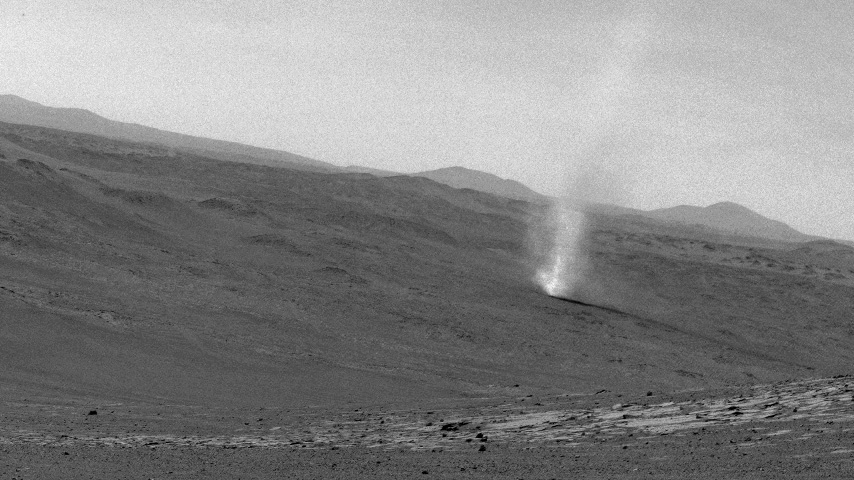The most recent spacecraft telemetry was acquired on Mar. 10 from the Deep
Space Network tracking complex at Goldstone, California. The Cassini
spacecraft is in an excellent state of health. Information on the present position and speed of the Cassini spacecraft may be found on the "Present Position" page at http://saturn.jpl.nasa.gov/operations/present-position.cfm.
Wednesday, March 4 (DOY 063)
Attitude and Articulation Control Subsystem (AACS) engineers performed
annual calibration tests on the Cassini Inertial Reference Unit today.
Results of the test showed continuing normal performance.
Once this activity was complete, the Imaging Science Subsystem (ISS),
Composite Infrared Spectrometer (CIRS), and Visual and Infrared Mapping
Spectrometer (VIMS) observed the F-Ring, then the Ultraviolet Imaging
Spectrograph (UVIS) mapped the volatiles in the immediate neighborhood of
Enceladus in order to test the connection of volatile changes to plume
eruptions.
Although not an image acquired by Cassini, the Astronomy Picture of the Day
for Mar. 4 gave a good depiction of what Saturn currently looks like through
a telescope. At opposition on Mar. 8, Saturn rises at sunset and sets at
sunrise, offering many hours of viewing enjoyment! If you don’t have access
to a telescope, contact one of the 400 members of the Cassini Saturn
Observation Campaign to find out where a viewing event will take place near
you. See http://saturn.jpl.nasa.gov/Education/saturnobservation/volunteermembers/ and http://antwrp.gsfc.nasa.gov/apod/ap090304.html.
Thursday, March 5 (DOY 064):
How is it that at one moment Cassini can be found nearly at apoapsis, the
farthest point from Saturn in an orbit, and within a day, be at periapsis,
the closest point to Saturn in an orbit, when its orbital period is around
16 days? Well, it is happening at the end of March this year. On DOY-86,
Mar. 27, the Titan 51 targeted flyby will occur. Just a few hours later,
apoapsis and the start of orbit #107 would have occurred. However, because
of the gravitational influence of Titan during the flyby, Cassini’s orbit is
modified such that apoapsis on the new Saturn centered orbit occurs prior to
the Titan encounter, on an orbit different from the one Cassini actually
flew. For orbit 107, on DOY-87, Mar. 28, Cassini is now at the closest point
to Saturn in that orbit. The above scenario is unique in the history of the
project and will not occur again before the end of the extended mission. The
fact that Cassini’s orbit about Saturn is very nearly circular at this time
is what enables this rather curious sequence of events.
Friday, March 6 (DOY 065):
An Uplink Readiness Review was held today which led to final approval for
the RCS thruster swap to the B branch.
Along with Orbit Trim Maneuver (OTM) #183, commands for the opening of Latch
Valve 41 (LV41) were sent to the spacecraft today. The LV41 commands will
execute on Mar. 10 and will enable the flow of hydrazine to the B-branch
thrusters.
Monday, March 9 (DOY 068):
A kick-off meeting was held today as part of the Science Operations Plan
(SOP) process for S53. In addition, all participating teams delivered files
and products for the Port 1 delivery as part of the SOP process for S52.
Orbit Trim Maneuver (OTM) #183 was performed today. This is the maneuver
setting up for the Titan 51 encounter on Mar. 27. The main engine burn
began at 2:30 AM PDT. Telemetry immediately after the maneuver showed the
burn duration was 29.88 seconds, giving a delta-V of 5.02 m/s. All
subsystems reported nominal performance after the maneuver.
Following the execution of OTM-183, a red alarm was detected in association
with one of the temperature sensors on the main engine combustion chamber,
and it appears that one of the two redundant sensors has failed. This will
have no effect on the planned RCS swap to the B side, nor to any future
operation of the main engine. It does mean that there is now one less level
of redundancy in monitoring the performance of the prime main engine.
Science observations today included a 3-hour observation by ISS, CIRS, and
UVIS to attempt to observe the illusive Rhea ring. An additional six hours
focused on Rhea will occur tomorrow. In addition, The Cosmic Dust Analyzer
(CDA) took data as Cassini passed through the ring plane.
Tuesday, March 10 (DOY 069):
After LV-41 was verified open today via telemetry, several files were sent
to the spacecraft to set the catalyst bed heaters for the B-branch to "Auto"
or “ON” except for when the thruster fires, deactivate the S48 background
sequence, and load the mini-background sequence that will execute from DOY
70-76. The last two files will take effect Mar. 12, just prior to AACS
branch swap commanding when the B-branch will be made prime.
The next and final live update in S48 was for Enceladus on DOY-080. After
analyzing the orbit determination solution from DOY-067, Science Planning
has determined that an update to pointing is not necessary and has
recommended that the live update be cancelled.


































